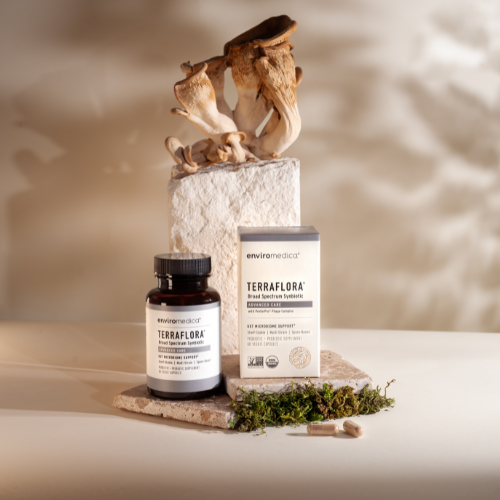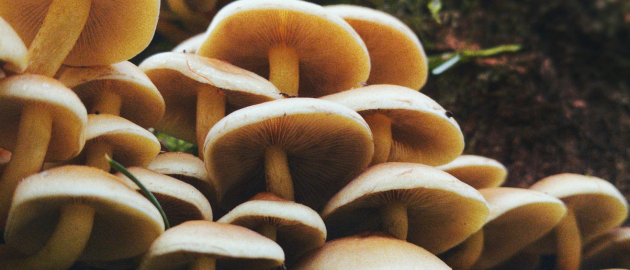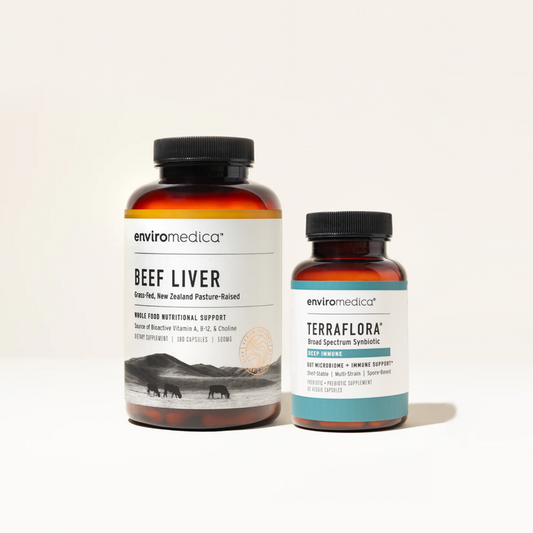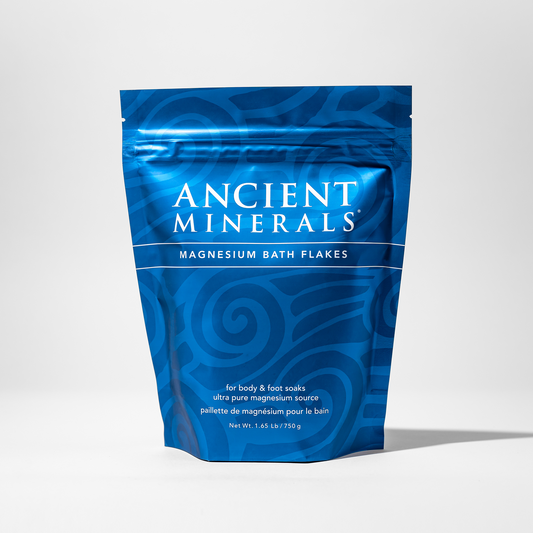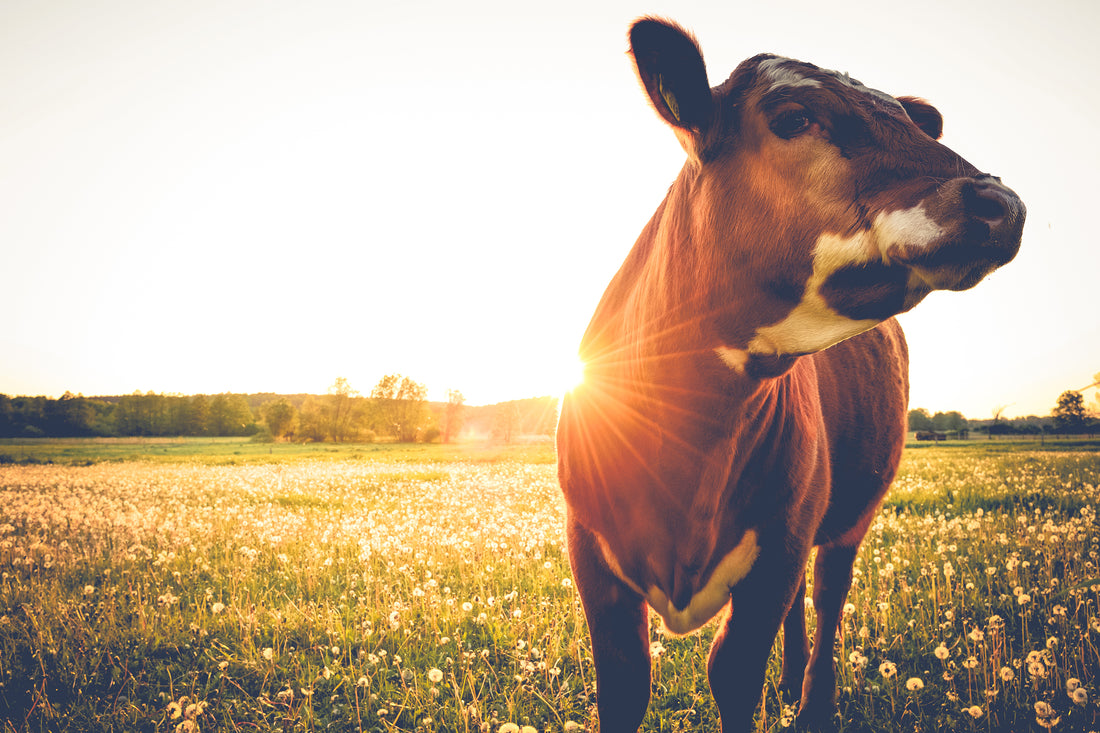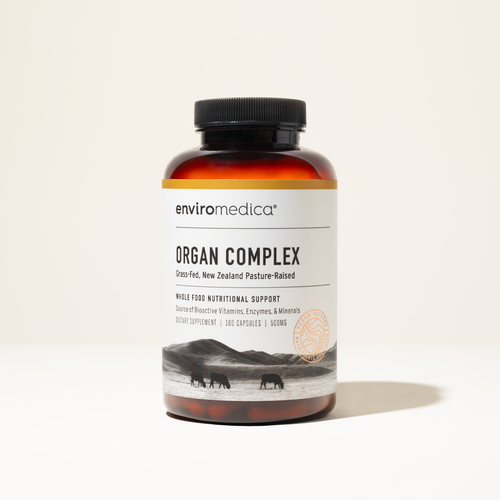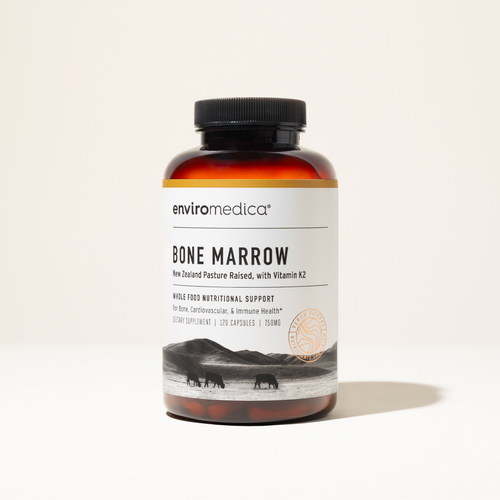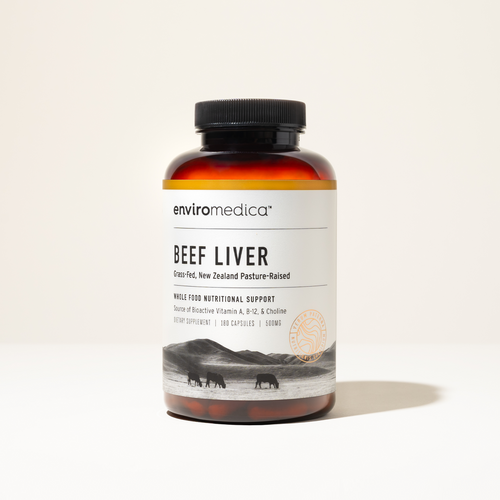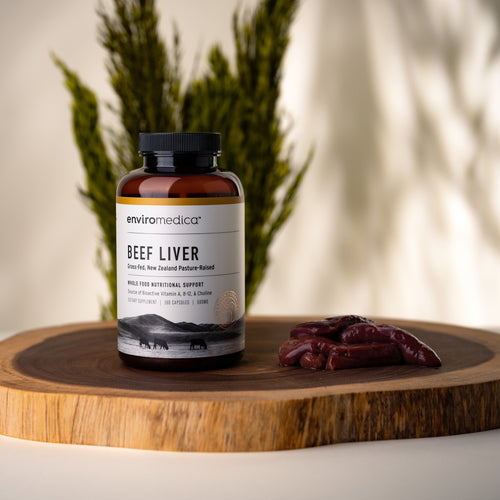Odds are that despite your best efforts to seek out and enjoy the highest quality foods available today, your body is still craving vital nutrients. Modern western foods are broadly deficient in nutrients 1, nutrients from key synergistic and bioactive compounds in foods that our ancestors harvested from the landscape and consumed routinely. Nutrients delivered to them in the form of organ meats.
Organ meats, collectively known as ‘offal’, include heart, liver, tongue, brain, tripe, pancreas, thymus, kidney, gallbladder and various other internal tissues. Even though organ meats contain highly bioavailable vitamins, minerals, fats, and amino acids, they are not regularly consumed in modern western society. In fact, organ meats are more economically valuable as an export product in the US 2.
Over the past century or so, many modern cultures have become so distant from the source of their food that the idea of eating organ meats may even prompt a visceral response (no pun intended).
So what exactly are you missing by NOT eating organ meats?
In answer to this question, we explore the evolutionary disconnect around organ meats, identify nutritional synergies within them that enable vitality, document the importance of sourcing high- quality organ meat from healthy animals, and provide a general re-introduction to these largely dismissed whole foods.
An Evolutionary Perspective
Before delving into the tradition of organ meats, it is worth taking a step back to see the bigger picture; an evolutionary perspective.
Human beings are one of countless species that evolved in lock-step with their ecosystem. Anthropologists have studied the evolutionary history of our species utilizing both morphological and genetic data to interpret the origins of Homo sapiens from 315,000 to potentially as old as 400,000 to 700,000 years ago3. That is a minimum of 301,000 years prior to archeobotancial evidence of plant domestication (ie. agriculture) 4, and about 300,900 years prior to the first self-service grocery store in the US.5 In other words, our human ancestors were shaped by:
- 301,000 years of hunting and gathering food from their local environment
- 13,900 years of agricultural innovation that functionally decreased food diversity, nutrition, and movement, while increasing their skeletal fragility and population 6, and
- 100 years of outsourcing our food production, movement, and choices altogether as the grocery store had ultimately become our new source of food. 7
This perspective is known as an ancestral perspective. It is through this lens that we observe and interpret human health in our modern environment. We are now quite far removed from the evolutionary forces that once shaped our species. We’ve largely opted out of our ecosystem and lost touch with our primal instincts.
But not all of us.
The Human Animal
Remember that humans are part of the animal kingdom. Our fellow mammals have very instinctive practices around hunting. Wolves in the wild preferentially consume the organ meats of their prey.8 9 Lions will also feast on the organs of their prey often leaving the muscle meat for the scavengers. This observation advanced the diets of lions in captivity to enable their reproductive success.10
Yes, there are differences between the ‘human animal’ and the ‘wild animal’: domestication, civilization, and innovation. There are perhaps as many similarities, including being shaped by nature, having an instinct, and a common ancestry.11 It is sometimes worth pondering our common ground.
Ancestral Practice
There are cultures around the world that either still practice their traditional life-way, such as the Hadza of Africa and the Copper Inuit in the Arctic 12 13 14, or are documented to have, like Indigenous American and Australian cultures.15 16 Traditionally, it is common practice to make the most of each animal hunted or fished from the wild; this includes consuming their internal organs and even using those organs medicinally.17 18
The Hadza of Tanzania have a post-hunt tradition of reserving organ meats for a select group of men collectively known as epeme. Epeme men have had a successful hunt and are typically 20-25 years old. Whether they prove to be hunters or not, by the time men reach the age of 30-35 years, they are also epeme.19 Epeme organ meats are only eaten in community with epeme men and never in the presence of women and non-epeme. Over time, this ritual guarantees Hadza men receive a ration of fat and vitamin-rich meat.20
The traditional Arctic Inuit are known to consume a diet of caribou muscle and organ meat as well as the skin, fat, and organs of fish and mammals from the sea.21, 22 Recent study of traditional Inuit culture compares their health status as favorable to the more ‘colonialized’ cultures that are transitioning away from their traditional diets.23 – 24
Indigenous North Americans in the Canadian Rockies consumed wild moose and caribou year-round. They learned that organ meats were superior to muscle meat and had medicinal properties. They often fed muscle meat to the dogs following a hunt.25 This group understood that the “two small balls in the fat” that sit atop the kidneys (what we have labeled the adrenal glands) protected them from scurvy.26
The nomadic Australian Aboriginal hunters ate the muscle and organ meats of wallaby, kangaroo, small animals, and rodents.27 The brain and liver were an important source of cholesterol and fat, primarily eaten raw or lightly cooked. In her paper entitled, Traditional diet and food preferences of Australian Aboriginal hunter-gatherers, O’Dea (1991) notes, “Everything on an animal carcass was eaten, including the small fat depots and organ meats (which were highly prized), bone marrow, peritoneal fluid, and blood.28”
Modern Practice
Today, our food source is primarily the grocery store. We select food to eat from the options available to us, options driven by the economy. With respect to meats in general, western society is offered little choice. The clear majority of Americans get to choose from the muscle meats of factory-farmed beef, chicken, and pork, with a seasonal side of turkey. The product at the store bears no resemblance to the original animal. All internal organs are considered ‘by-product’ or ‘variety meat’ and are more profitable to sell as pet food or to export to other countries.29
In fact, the only organ meats included in an NIH report outlining trends in US meat consumption were giblets.30
It is important to highlight here that while our ancestors ate meat from wild game, we do not. The animals from which most meat in the US is derived are farmed in captivity and raised on foods not in their natural diet. While this fattens them up for sale, it does not make them healthy and it does not make the meats from them as nutritious as they should be.31 More on this point below.
Notes from our rich ancestral past and global communities relay a different story than we live today. Prized, celebrated, medicinal and otherwise commonly consumed organ meats are missing from our plates.
But what exactly are we missing?
Nutritional Profile of Organ Meats
An ancestral perspective teaches us that the whole food is superior to its isolated nutrients. For hundreds of thousands of years, there was no concept of vitamin B12 – let alone a B12 supplement. Our ancestors were keenly aware that organ meats enabled vitality.
Today we understand that highly complex biochemical processes take place within the body when foods are consumed. We understand these processes require multiple nutrients to proceed successfully, a concept known as nutrient synergy. When whole foods are eaten, nutrients in their natural synergist amounts are received.32 33 Said another way, whole food should be the standard of care to address nutrient deficiencies.
Thankfully, we do know a bit about the nutrients that compose organ meats, and they are plenty.
Nutrient Density
Nutrient density is just like it sounds, the amount of nutrition per calorie.34 On one end of the spectrum are energy dense or high calorie foods full of sugar that contain little to no nutrients; near zero nutrient density. On the other end of the spectrum, well, there’s liver with more nutrients than many people get in a day.35
Organ meats are some of the most nutrient dense foods on the planet. They contain abundant bioavailable B12, several B-complex vitamins, fat-soluble vitamins A, D, E, and K2, bioavailable iron, copper, magnesium, and a beneficial omega-3 to omega-6 fatty acid ratio.36 They are naturally enriched in nutrients that we require. A bit of detail about liver, heart, kidney, and pancreas follows (see also Table 1).
- Liver – This organ converts nutrients in the food into compounds the body can use. It also helps the body to neutralize (not store) toxins.37 It is one of the most enriched sources of preformed vitamin A (retinol), a 1-oz serving has almost 100% of your daily requirement. That same serving will provide you with 2.75x your daily requirement of vitamin B12, a vitamin that is most bioavailable from animal sources.38 It contains synergistic amounts of vitamin D, E, K, B1, B2, B6, folate, bioavailable iron, copper, phosphorus, potassium, magnesium, manganese, choline, and essential fatty acids.39 For these reasons, it is no wonder liver is sometimes referred to as the superfood of the animal kingdom. The consumption of liver is documented as a treatment for the B12 deficiency of pernicious anaemia.40
- Heart – Heart is technically a muscle, giving it a more familiar texture. It is a bioelectric organ that assists in the delivery of nutrients around the body.41 Heart is a great source of coenzyme-Q1042, copper, selenium, and iron. It also contains B12, folic acid, phosphorus, and zinc. Heart is a rich source of collagen, an important nutrient for connective tissue health.43 44
- Kidney – The kidneys remove waste from the bloodstream, help to regulate sodium, potassium, and calcium levels in the body, and secrete a hormone that influences blood pressure.45 They are rich in vitamin A, vitamin D, B12, niacin, selenium, iron, zinc, copper, potassium, and phosphorus.46
- Pancreas – The pancreas is often grouped into a category of organ meat called ‘sweetbreads’. Functionally, it secretes digestive enzymes and produces hormones that regulate blood sugar.47 Due to its purpose in the body, raw pancreas therapy was once used to treat high blood sugar.48 49 The organ itself is rich in vitamin C, B12, B5, B2, B3, selenium, potassium, phosphorus, iron, and zinc.50
More Synergies
Bioactive compounds are ‘extra nutritional’ compounds that confer health benefits.51nts known as phytochemicals, however, there are also several bioactive compounds (or bioactive peptides) in organ meats that are noteworthy, including: antioxidants, antihypertensive, anti-inflammatory, cytomodulatory, immunomodulatory, hypocholesterolemic, antimicrobial, and antithrombotic compounds to name a few.52
Although they did not have our labels, our ancestors had this knowledge. They valued organ meats for their vital properties.
Table 1. Nutritional Data for Organ Meats
| per 100g | Liver | Heart | Kidney | Pancreas | |
| beef, raw | beef, raw | beef, raw | beef, raw | ||
| Carbohydrates | g | 3.9 | 0.1 | 0.3 | 0.0 |
| Fats | g | 3.6 | 3.9 | 3.1 | 18.6 |
| saturated | g | 1.2 | 1.4 | 0.9 | 6.4 |
| monounsaturated | g | 0.5 | 1.1 | 0.6 | 6.4 |
| polyunsaturated | g | 0.5 | 0.5 | 0.5 | 3.5 |
| omega-3 | mg | 7.0 | 11.0 | 7.0 | 130.0 |
| omega-6 | mg | 318 | 407.0 | 310.0 | 2030.0 |
| Protein | g | 20.4 | 17.7 | 17.4 | 15.7 |
| Vitamin A | IU | 16899.0 | – | 1397.0 | 0.0 |
| Vitamin C | mg | 1.3 | 2.0 | 9.4 | 13.7 |
| Vitamin D | IU | 16.0 | – | 32.0 | – |
| Vitamin E | mg | 0.4 | 0.2 | 0.2 | – |
| Vitamin K | mg | 2.8 | – | – | – |
| Thiamin | mg | 0.2 | 0.2 | 0.4 | 0.1 |
| Riboflavin | mg | 2.8 | 0.9 | 2.8 | 0.4 |
| Niacin | mg | 13.2 | 7.5 | 8.0 | 4.5 |
| Vitamin B6 | mg | 1.1 | 0.3 | 0.7 | 0.2 |
| Folate | mcg | 290.0 | 3.0 | 98.0 | 3.0 |
| Vitamin B12 | mcg | 59.3 | 8.5 | 27.5 | 14.0 |
| Pantothenic Acid | mg | 7.2 | 1.8 | 4.0 | 3.9 |
| Choline | mg | 333.0 | – | – | – |
| Calcium | mg | 5.0 | 7.0 | 13.0 | 9.0 |
| Iron | mg | 4.9 | 4.3 | 4.6 | 2.2 |
| Magnesium | mg | 18.0 | 21.0 | 17.0 | 18.0 |
| Phosphorus | mg | 387.0 | 212.0 | 257.0 | 327.0 |
| Potassium | mg | 313.0 | 287.0 | 262.0 | 276.0 |
| Sodium | mg | 69.0 | 98.0 | 182.0 | 67.0 |
| Zinc | mg | 4.0 | 1.7 | 1.9 | 2.6 |
| Copper | mg | 9.8 | 0.4 | 0.4 | 0.1 |
| Manganese | mg | 0.3 | – | 0.1 | 0.2 |
| Selenium | mcg | 39.7 | 21.8 | 141.0 | 24.7 |
| Nutrition data from http://nutritiondata.self.com/ | |||||
The Importance of Source
If we are to rely on the vital organs of an animal for nutrients and vitality, then it is of the utmost importance that those organs be sourced from healthy, naturally raised animals. When sourcing beef organs, for example, a primary consideration is that the cow could feed on pasture for its entire life. An even superior scenario would be that the cow grazed on organic pasture grown without synthetic fertilizers, herbicides, or pesticides.
In the US, conventionally raised cows are fed grain to quickly and economically increase their size for market. Grains are not what cows would choose to eat. Cows are designed by nature to eat grass and to convert that chlorophyll-rich plant (cellulose) into milk and lean muscle via fermentation in a 4-chambered stomach.53
There is research available on the nutritive value of meat and organs from grass-fed vs grain-fed cows. Time and time again the comparison is clear; meat and organs from grass-fed cows offer superior nutrition. It is enhanced in conjugated linoleic acid (CLA), has higher levels of Vitamins A and E, contains more antioxidants, is leaner, and is a visually distinct yellow color from the carotenoid content of the fat.54–55,56
One of the premier sources for healthy grass-fed cows are the pastures of New Zealand. New Zealand has banned GMO’s 57 and therefore their Angus cows eat grass grown from non-GMO seed. Studies of the nutrient content of meats from grass-fed cows raised on New Zealand pasture document omega-3 (30mg/100g) content to be high enough to be considered a source food in Australia and New Zealand.58
Incorporating Organ Meats
In summary, organ meats:
- are traditionally consumed worldwide
- were eaten and prized by our ancestors
- are medicinal to some cultures
- are highly nutrient dense whole foods
- and should be sourced from animals raised in their most natural environment
Now that you are aware of the benefits of organ meats, you may be wondering the best way to begin to incorporate organ meats into your diet. You may also still feel some resistance to this, given the stigma attached to consuming organs in the world in which we live.
If you do feel adventurous, beef liver is a relatively easy organ to experiment with for several reasons. First, liver packed with nutrients and might be more visually appealing to you. When handling beef liver you will undoubtedly begin with a fraction of the entire organ as the liver is the largest internal organ and will be cut into smaller pieces for purchase. With other organs, you are more likely to receive the entire – and more recognizable – heart, kidney, pancreas or tongue. Second, liver is easier to prepare and cook. To prepare beef liver, you simply cut it into the size pieces that you’d like, as opposed to the probability that you’ll have to remove tougher parts or outer skin on other organs prior to cooking. Third, you might even find ‘Liver and Onions’ on the menu at your favorite American diner, whereas other organs are less familiar fare.
However, as all organ meats are traditionally consumed in most other countries today, there are many resources online to connect you with a global array of traditional ‘offal’ dishes. Identify your own roots and seek your own ancestral cuisine. Whether it’s haggis or humble pie, head cheese or menudo, pho or pacha, always be mindful of the source of your ingredients. This is particularly true when traveling given the US exports quite a bit of factory farmed organ meats to other countries.59
If you are still interested in reaping the health benefits of organ meat but you are certain that preparing and eating them is just not your thing, you can readily supplement with quality freeze-dried organ meats. Be sure to scrutinize the product source to ensure the highest quality nutrition from the most sustainably and naturally raised animals.
With so many options available to you, how will you get organ meats on your plate?
References
- 1. Price, W. A. 1939. Nutrition and physical degeneration; a comparison of primitive and modern diets and their effects, New York, London,, P.B. Hoeber.
- 2. Calton, J. B. 2010. Prevalence of micronutrient deficiency in popular diet plans. J Int Soc Sports Nutr, 7, 24.
- 3. Ward, E. 2014. Addressing nutritional gaps with multivitamin and mineral supplements. Nutr J, 13, 72.
- 4. Gepts, P. a. P., R. 2003. Evolution during Domestication, John Wiley & Sons Ltd, Chichester.
- 5. Eschner, K. 2017. The Bizarre Story of Piggly Wiggly, the First Self-Service Grocery Store: What’s in a name? [Online]. SMITHSONIAN.COM Available: https://www.smithsonianmag.com/smart-news/bizarre-story-piggly-wiggly-first-self-service-grocery-store-180964708/ [Accessed].
- 6. Ryan, T. M. & Shaw, C. N. 2015. Gracility of the modern Homo sapiens skeleton is the result of decreased biomechanical loading. Proc Natl Acad Sci U S A, 112, 372-7.
- 7. O’keefe, J. H., Vogel, R., Lavie, C. J. & Cordain, L. 2011. Exercise like a hunter-gatherer: a prescription for organic physical fitness. Prog Cardiovasc Dis, 53, 471-9.
- 8. Stahler, D. R., Smith, D. W. & Guernsey, D. S. 2006. Foraging and feeding ecology of the gray wolf (Canis lupus): lessons from Yellowstone National Park, Wyoming, USA. J Nutr, 136, 1923S-1926S.
- 9. Wikenros, C., Sand, H., Ahlqvist, P. & Liberg, O. 2013. Biomass flow and scavengers use of carcasses after re-colonization of an apex predator. PLoS One, 8, e77373.
- 10. Price, W. A. 1939. Nutrition and physical degeneration; a comparison of primitive and modern diets and their effects, New York, London,, P.B. Hoeber.
- 11. Theobald, D. L. 2010. A formal test of the theory of universal common ancestry. Nature, 465, 219-22.
- 12. Hawkes, K., O’connell, J. F. & Blurton Jones, N. G. 2001. Hadza meat sharing. Evol Hum Behav, 22, 113-142.
- 13. Marlowe, F. W. 2010. The Hadza Hunter-Gatherers of Tanzania, University of California Press.
- 14. Ember, C. R. 2014. Hunter-Gatherers (Foragers). In: EMBER, C. R. (ed.) Explaining Human Culture. http://hraf.yale.edu/ehc/summaries/hunter-gatherers.
- 15. Price, W. A. 1939. Nutrition and physical degeneration; a comparison of primitive and modern diets and their effects, New York, London,, P.B. Hoeber.
- 16. O’dea, K. 1991. Traditional diet and food preferences of Australian aboriginal hunter-gatherers. Philos Trans R Soc Lond B Biol Sci, 334, 233-40; discussion 240-1.
- 17. Kuhnlein, H. V. a. H. M. M. Traditional Animal Foods of Indigenous Peoples of Northern North America: The contributions of wildlife diversity to the subsistence and nutrition of indigenous cultures [Online]. McGill. Available: http://traditionalanimalfoods.org/mammals/hoofed/page.aspx?id=6136 [Accessed 2018].
- 18. Alves, R. R. & Alves, H. N. 2011. The faunal drugstore: animal-based remedies used in traditional medicines in Latin America. J Ethnobiol Ethnomed, 7, 9.
- 19. Marlowe, F. W. 2010. The Hadza Hunter-Gatherers of Tanzania, University of California Press.
- 20. Marlowe, F. W. 2010. The Hadza Hunter-Gatherers of Tanzania, University of California Press.
- 21. Price, W. A. 1939. Nutrition and physical degeneration; a comparison of primitive and modern diets and their effects, New York, London,, P.B. Hoeber.
- 22. Fediuk, K., Hidiroglou, N., Madère, R. & Kuhnlein, H. V. 2002. Vitamin C in Inuit Traditional Food and Women’s Diets. Journal of Food Composition and Analysis, 15, 221-235.
- 23. Lougheed, T. 2010. The changing landscape of arctic traditional food. Environ Health Perspect, 118, a386-93.
- 24. Schaefer, S. E., Erber, E., Trzaskos, J. P., Roache, C., Osborne, G. & Sharma, S. 2011. Sources of food affect dietary adequacy of Inuit women of childbearing age in Arctic Canada. J Health Popul Nutr, 29, 454-64.
- 25. Price, W. A. 1939. Nutrition and physical degeneration; a comparison of primitive and modern diets and their effects, New York, London,, P.B. Hoeber.
- 26. Price, W. A. 1939. Nutrition and physical degeneration; a comparison of primitive and modern diets and their effects, New York, London,, P.B. Hoeber.
- 27. Price, W. A. 1939. Nutrition and physical degeneration; a comparison of primitive and modern diets and their effects, New York, London,, P.B. Hoeber.
- 28. O’dea, K. 1991. Traditional diet and food preferences of Australian aboriginal hunter-gatherers. Philos Trans R Soc Lond B Biol Sci, 334, 233-40; discussion 240-1.
- 29. Marti, D. L., Johnson, R. J. & Mathews, K. H. 2012. Where’s the (Not) meat? Byproducts from beef and pork production.
- 30. Daniel, C. R., Cross, A. J., Koebnick, C. & Sinha, R. 2011. Trends in meat consumption in the USA. Public Health Nutr, 14, 575-83.
- 31. Daley, C. A., Abbott, A., Doyle, P. S., Nader, G. A. & Larson, S. 2010. A review of fatty acid profiles and antioxidant content in grass-fed and grain-fed beef. Nutr J, 9, 10.
- 32. Colbin, A. 2002. Wholistic nutrition: From biochemistry to chaos, complexity, and quantum physics. Applying some concepts from contemporary science to a new understanding of how food affects health. In: ARDITTI, R. (ed.). ProQuest Dissertations Publishing.
- 33. Jacobs, D. R., Jr., Gross, M. D. & Tapsell, L. C. 2009. Food synergy: an operational concept for understanding nutrition. Am J Clin Nutr, 89, 1543S-1548S.
- 34. Drewnowski, A. 2005. Concept of a nutritious food: toward a nutrient density score. Am J Clin Nutr, 82, 721-32.
- 35. Beef, variety meats and by-products, liver, raw Nutrition Facts & Calories [Online]. SELFNutritionData: know what you eat. Available: http://nutritiondata.self.com/facts/beef-products/3468/2 [Accessed].
- 36. Williams, P. 2007. Nutritional composition of red meat. Nutrition & Dietetics, 64, S113-S119.
-
37. How does the liver work? [Online]. PubMed Health. Available: https://www.ncbi.nlm.nih.gov/pubmedhealth/PMH0072577/ [Accessed].
- 38. Watanabe, F. 2007. Vitamin B12 sources and bioavailability. Exp Biol Med (Maywood), 232, 1266-74.
- 39. Beef, variety meats and by-products, liver, raw Nutrition Facts & Calories [Online]. SELFNutritionData: know what you eat. Available: http://nutritiondata.self.com/facts/beef-products/3468/2 [Accessed].
- 40. Kumar, N., Boes, C. J. & Samuels, M. A. 2006. Liver therapy in anemia: a motion picture by William P. Murphy. Blood, 107, 4970.
- 41. How does the heart work? [Online]. PubMed Health. Available: https://www.ncbi.nlm.nih.gov/pubmedhealth/PMH0072433/ [Accessed].
- 42. Saini, R. 2011. Coenzyme Q10: The essential nutrient. J Pharm Bioallied Sci, 3, 466-7.
- 43. Neuman, R. E. & Logan, M. A. 1950. The determination of collagen and elastin in tissues. J Biol Chem, 186, 549-56.
- 44. Beef, variety meats and by-products, heart, raw Nutrition Facts & Calories [Online]. SELFNutritionData: know what you eat. Available: http://nutritiondata.self.com/facts/beef-products/3464/2 [Accessed].
- 45. Kidney [Online]. PubMed Health. Available: https://www.ncbi.nlm.nih.gov/pubmedhealth/PMHT0022152/ [Accessed].
- 46. Beef, variety meats and by-products, kidneys, raw Nutrition Facts & Calories [Online]. SELFNutritionData: know what you eat. Available: http://nutritiondata.self.com/facts/beef-products/3466/2 [Accessed].
- 47. How does the pancreas work? [Online]. PubMed Health. Available: https://www.ncbi.nlm.nih.gov/pubmedhealth/PMH0072490/ [Accessed].
- 48. Neve, E. F. 1926. Raw Pancreas In Diabetes Mellitus. The British Medical Journal, 1, 476-476.
- 49. Edwards, M. 2004. Good, bad or offal? The evaluation of raw pancreas therapy and the rhetoric of control in the therapeutic trial, 1925. Ann Sci, 61, 79-98.
- 50. Beef, variety meats and by-products, pancreas, raw Nutrition Facts & Calories [Online]. SELFNutritionData: know what you eat. Available: http://nutritiondata.self.com/facts/beef-products/3474/2 [Accessed].
- 51. Kris-Etherton, P. M., Hecker, K. D., Bonanome, A., Coval, S. M., Binkoski, A. E., Hilpert, K. F., Griel, A. E. & Etherton, T. D. 2002. Bioactive compounds in foods: their role in the prevention of cardiovascular disease and cancer. Am J Med, 113 Suppl 9B, 71S-88S.
- 52. Fayemi, P. O., Muchenje, V., Yetim, H. & Ahhmed, A. 2018. Targeting the pains of food insecurity and malnutrition among internally displaced persons with nutrient synergy and analgesics in organ meat. Food Res Int, 104, 48-58.
- 53. Orr, A. I. How Cows Eat Grass: Exploring Cow Digestion [Online]. FDA U.S. Food & Drug. Available: https://www.fda.gov/AnimalVeterinary/ResourcesforYou/AnimalHealthLiteracy/ucm255500.htm [Accessed].
- 54. Enser, M., Hallett, K. G., Hewett, B., Fursey, G. A., Wood, J. D. & Harrington, G. 1998. The polyunsaturated fatty acid composition of beef and lamb liver. Meat Sci, 49, 321-7.
- 55. Leheska, J. M., Thompson, L. D., Howe, J. C., Hentges, E., Boyce, J., Brooks, J. C., Shriver, B., Hoover, L. & Miller, M. F. 2008. Effects of conventional and grass-feeding systems on the nutrient composition of beef. J Anim Sci, 86, 3575-85.
- 56. Daley, C. A., Abbott, A., Doyle, P. S., Nader, G. A. & Larson, S. 2010. A review of fatty acid profiles and antioxidant content in grass-fed and grain-fed beef. Nutr J, 9, 10.
- 57. 1996. Hazardous Substances and New Organisms Act 1996. 1996 No 30. Parliament Counsel Office; New Zealand.
- 58. Ponnampalam, E. N., Mann, N. J. & Sinclair, A. J. 2006. Effect of feeding systems on omega-3 fatty acids, conjugated linoleic acid and trans fatty acids in Australian beef cuts: potential impact on human health. Asia Pac J Clin Nutr, 15, 21-9.
- 59. Marti, D. L., Johnson, R. J. & Mathews, K. H. 2012. Where’s the (Not) meat? Byproducts from beef and pork production.
